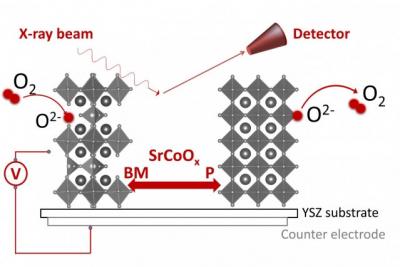Researchers at MIT developed a thin-film material whose phase and electrical properties can be switched between metallic and semiconducting, simply by applying a small voltage. The material then stays in its new configuration until switched back by another voltage. The discovery could pave the way for a new kind of nonvolatile computer memory chips that retain information when the power is switched off, and for energy conversion and catalytic applications.

The researchers demonstrated that electrical bias can induce a phase transition in the material, which was achieved by changing the oxygen content in material. This work involves the thin-film material strontium cobaltite (SrCoOx), which has two different structures depending on how many oxygen atoms per unit cell it contains. When more oxygen is present, SrCoOx forms the tightly-enclosed, cage-like crystal structure of perovskite, whereas a lower concentration of oxygen produces the more open structure of brownmillerite.
The researchers found that the material can be flipped between the two forms with the application of a very tiny amount of voltage ' just 30 millivolts. And, once changed, the new configuration remains stable until it is flipped back by a second application of voltage.
The ability to trigger such a phase change through the use of just a tiny voltage could open up many uses for these materials, like electrodes in fuel cells, membranes that allow oxygen to pass through for gas separation, and electronic devices such as memristors ' a form of nonvolatile, ultrafast, and energy-efficient memory device.

